Stair Railing DIY Makeover
Please subscribe to my YouTube channel to see more great projects!
For your convenience, affiliate links are included in this post.
Our Outdated Oak Baluster
You might remember from my house tour that we live in a bi-level home. Guests enter our home and walk up five stairs into the living room. The stair railing that is at the top of those stairs can be seen in this photo:
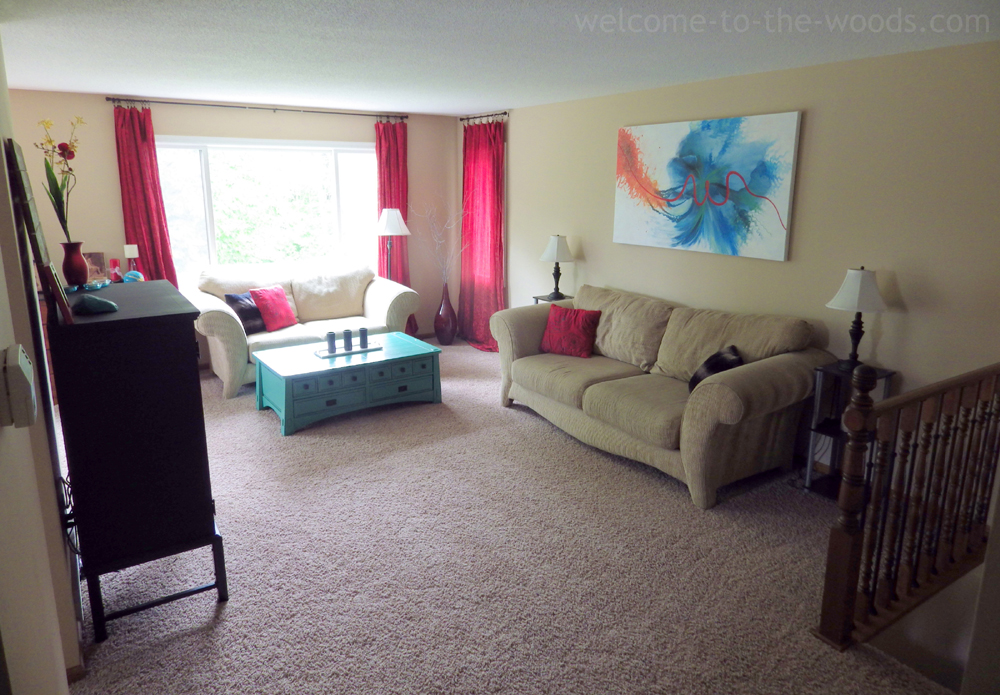
My living room recently underwent a major makeover, so let me show you a more up-to-date photograph from a different angle.
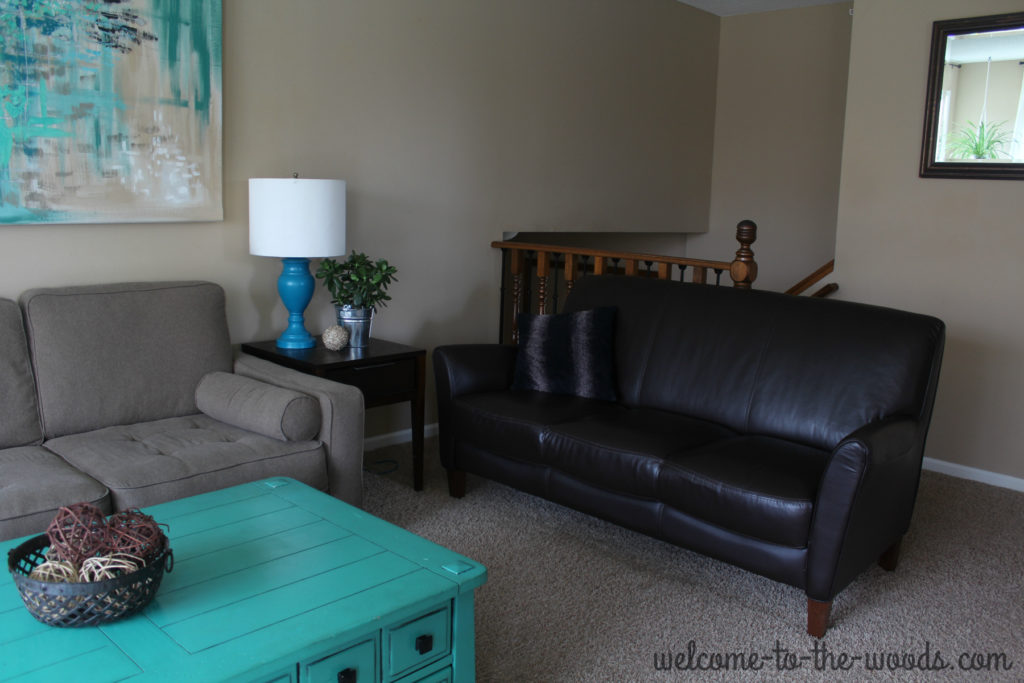
Now with my updated furniture, this stair railing just had to go. It did not fit with my aesthetic and I had dreams of something more modern and sleek.
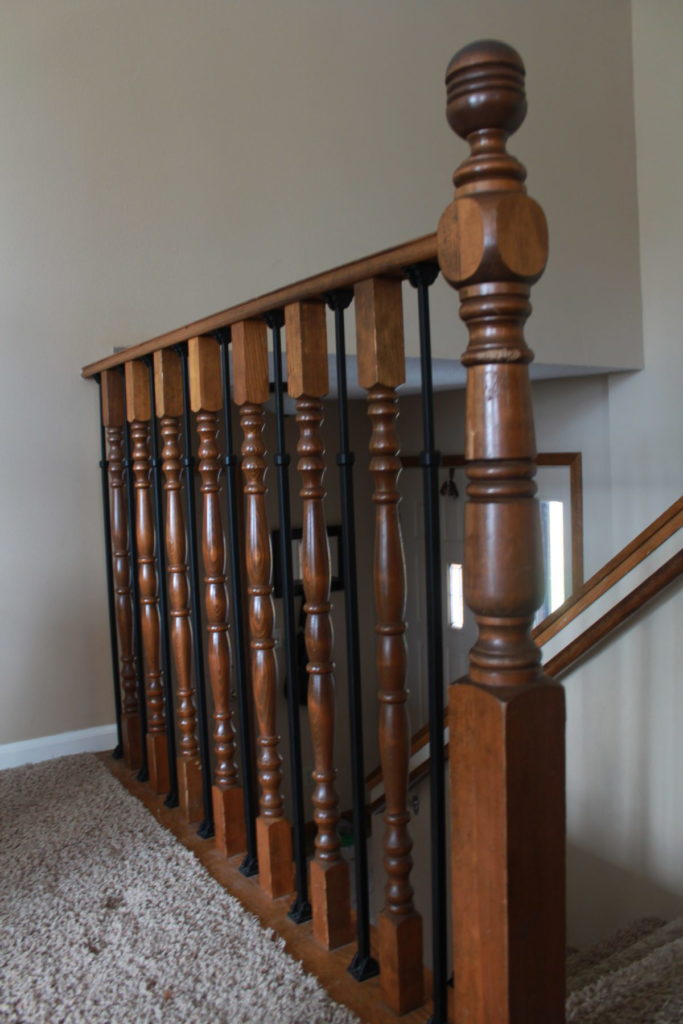
You can find a little bit of knowledge from this blog post, this is the post that got my wheels turning. They used metal conduits to construct a stair railing and cut it to size, securing it to the wall with MDF.
I didn’t take step-by-step photos of myself completing this project because I have something even better! My stair railing DIY makeover has been videotaped and sped up for you to see. I do have a complete materials list and cost below. If you would like more information about how I did something, please ask in the comments!
Stair Railing Materials
I designed this stair railing using metal as well as wood in a horizontal orientation for a contemporary look. I chose steel conduit as my metal because I could cut it with an angle grinder to my desired length, measuring about 1/4″ less than needed so I could wiggle it into place.
Steel Conduit four 1/2″ by 10′ poles = $9.32
Black Spray Paint for the Conduit = $2.99 (on sale!)
For the wood newel post, I bought 1/4″ thick MDF and used a brad nailer to attach it to the existing post. I couldn’t access the newel post through the basement ceiling, so I just built off what was already there and I knew was stable. I bought the topper and bottom skirt as pre-made pieces. They were originally meant for outdoor decks, but I didn’t see why I couldn’t have them indoors. Building my own newel post with parts instead of buying a pre-made one saved me more than $100.
2′ by 4′ piece of 1/4″ thick MDF = $4.34
Post Cap = $5.00 (on sale!)
Post Skirt = $1.00 (on sale!)
Another, thicker post skirt = $2.89 (I had to buy & cut to size for the half post against my wall. It looks like the cap on the newel post, sort of.)
1″ by 4″ quality pine board = $2.92
I did have to buy a few tools I didn’t already have, like a caulk gun and the 3/4″ spade bit
for drilling the holes. These amounted to about $6 and I’m not adding them into my material total. However, I did buy paintable caulking and liquid construction adhesive. The adhesive was used to secure the conduit bars in their holes.
Paintable Caulk = $1.89
Construction Adhesive = $2.49
TOTAL COST for MATERIALS = 32.84
Stair Railing DIY Makeover
Now enjoy some photos of the amazing before and after stair railing DIY makeover!

The transformation has been incredible. The look and feel of our house has completely changed when people enter up the steps.
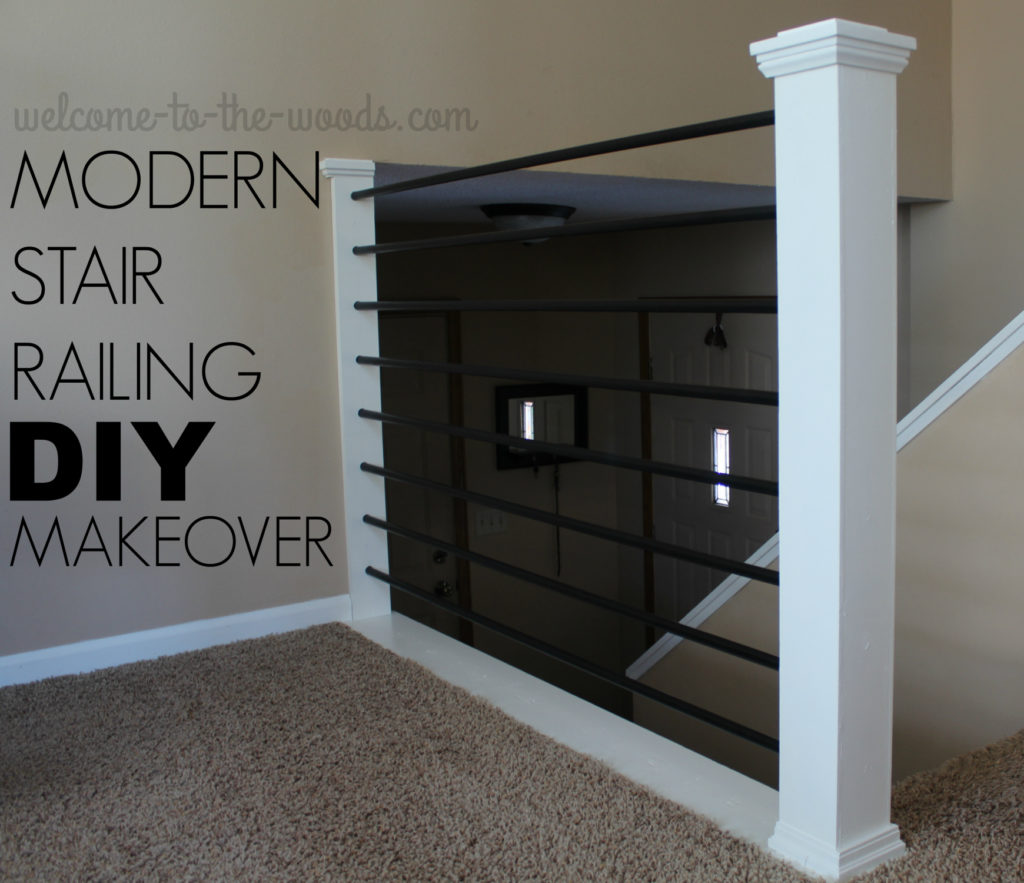
Of course, feel free to pin as you please!
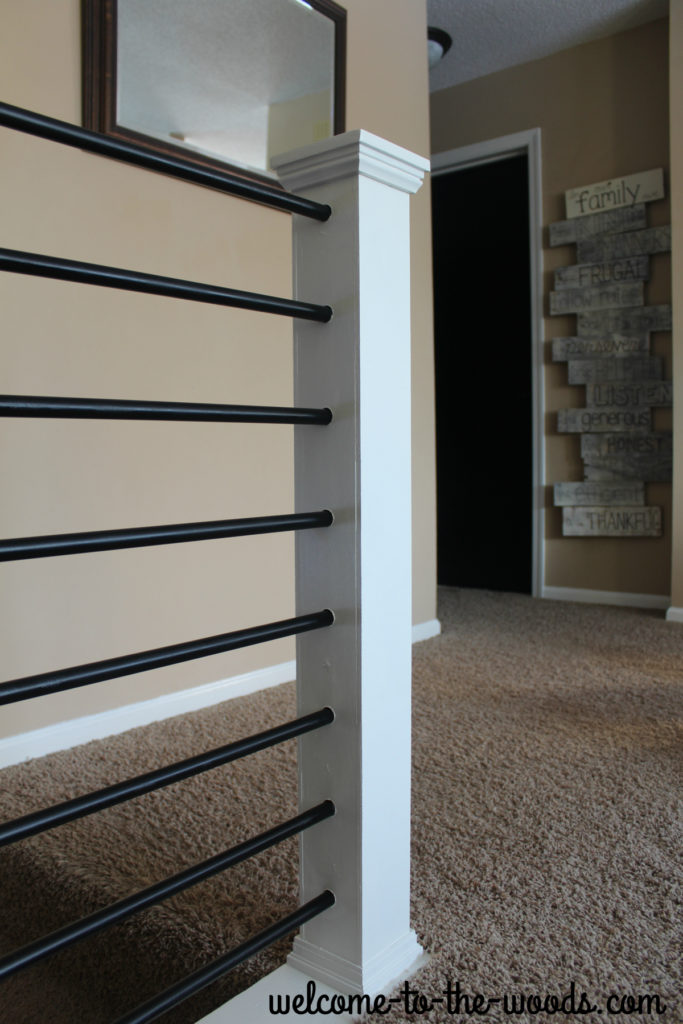
So the newel post has the 1/4″ thick MDF refacing it and the piece inside is where I pre-drilled holes with a 3/4″ spade bit for the conduit to rest. I did drill into the existing newel post itself a tad and cut the conduit to a length where they would go into the post and not just rely on the strength of the MDF to hold them up. Oh and by the way, doesn’t my sign of family values wall decor look awesome in the background!? Everything is coming together so nicely since I painted my trim white and the doors black.

After the conduit was inside the post, I used liquid construction adhesive to secure them in place so they didn’t slide. If you watch the video above, you’ll see how I just added some adhesive in the crevices between the hole and conduit.
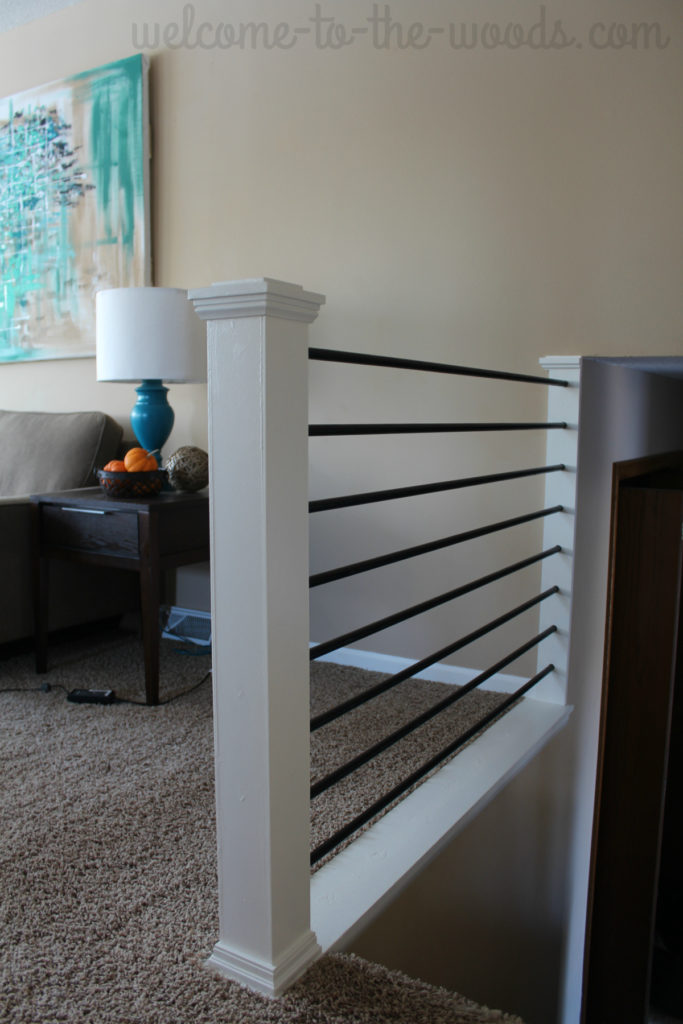
It is so beautiful, isn’t it!?
Ok, last photo. Be sure to pin this one!

Thank you so much for reading about my stair railing DIY makeover! This project only took me 5 days from start to completion with a lot of planning and a little help from my kids (as you saw in the video). I worked so hard on it and would be honored if you were inclined to share this project with your friends! Come back soon to see my Christmas decor, I am planning to hang our stockings on the new stair railing!

This really opens up your room and your design would work not only modern styles, but also blend with transitional styles of decor. I would gently remind you that seniors and young children would appreciate having the handrail you removed, even though you have a short run of stairs. To save space you could use one made of the conduit pipe. Thank you for the tutorial. I have been looking for an affordable way to update our staircase, What a creative woman you are!
Thank you, Joan! I did consider doing a new handrail as well, but I figured I would wait a few months and see if it was missed because I prefer it not there. Come back again!
Melissa
Love the transformation… haha and the kids in the video too 🙂
Thank you! 🙂
Love it…has the paint on the metal come off at all?
Thank you Camie! No, I used Rust-O-Leum spray paint which is oil based and is meant to bond and stick to metal. The link is in my materials list above!
Melissa
Looks great, but is there not a concern that young children will be able to climb horizontal rungs? This is not allowed in our building code in Ontario.
Hi Mal! Thank you for your comment. It’s really not a concern for our household as my children don’t climb, are obedient listeners, and are never near the stairs because there is a couch in front of it. I would be more leery to do a project like this at the top of tall stairs, but this railing is protection from just five carpeted steps. The building code in the state I live does not specify against horizontal rungs and this railing does meet spacing as well as weight bearing requirements.
Melissa
Beautifully done video and great update to the room/area.
Would you think a thicker conduit would work well and be more sturdy? Looking to do this remodel but on a staircase going at an angle.
I think a thicker conduit would have less flex and be more sturdy, yes. This might be tricky to do at an angle because you can’t get a precise cut with an angle grinder to cut the conduit to length. Perhaps use a small metal saw and break the conduit so that the ends are cut at the angle you need?
Firstly, you and kids are adorable. The rails look fantastic!
Have been sooo sick of my yellow oak everywhere. Decided I wanted to make a dramatic change and spotted your reno. Just what I had in mind. I’m going for it, would like to incorporate barn board…..but I’ll leave it to the professionals. Thirty years ago, I might have been motivated to do myself. Not so much now.
Thanks for the compliment Monica! Best of luck with yours! 🙂
Melissa
Got to love and respect a woman who can wield tools like you do; beautiful job!
Thanks!
Wow….that’s amazing that you did that all by yourself!
Thank you!
Love it! It modernizes your space.
I agree! Thanks!
I like your stair well railing, it looks nice but I really liked the older look one better.
To me it looks sturdier . The small railing looks like it wouldn’t take much for someone to push through it.
Thanks for sharing it with us.
You did a FABULOUS young lady…WooooHoooo!!!!!
Thank you Candy! <3
Amazing work.
I was wondering if this is possible to do for more than few steps, I am thinking about 17 steps and railing(some of the steps have a curve at the bottom)
Thank you
Thank you Kumar! I think as a railing along the side of steps it should work fine, but I would trust it at the top of a set of 17 steps. Conduit is not as strong as a wood railing would be. Good luck with your project!
Melissa
I absolutely love this design! I would think this would also work well outside on a deck! I am sure other materials could be used to make it sturdier for higher decks. I am going to do this too!! Thanks so much for sharing this; you are awesome!
Thank you! I have really enjoyed it the last year and I get a lot of compliments on it from people entering my home. Good luck with your design!
All that talent ,& Children also , love what you did with the stair rail
Thank you Maura!!
Looking for ideas to transform an oak staircase. You did a fantastic job! I am inspired although scared to tackle this by myself, but I certainly appreciate what you’ve done here.
Im inspired. Thanks for sharing.
You are so amazing! We used wood instead of MDF for added strength and redid our whole staircase. Ended up paying about $80 for material but it opened up my floor plan so much. Also 2 by 4’s for the side posts. Ended up being super sturdy! Thank you
Wonderful! Did you do your project before or after finding my stair railing redo? I would love to see a picture of it Cristina!
I love this! I also have a railing going up the stairs, that would be at an angle. I’m trying to figure out how I would space the holes for the conduit. Any tips? Thanks so much!
You could still space them the same, measured evenly. You would just need to cut the conduit at a 45 degree angle so they would join the newel post flush at an angle. Does that make sense?
Good luck Jamie!
Melissa
Please note that this may not be up to code. There can not be a horizontal “guard or baluster” for stairs or guard rails that is on staircases that have 3 or more stairs. It can be only be vertical and also spaced in such a way that a tennis ball does not go through freely. Especially if small children at home they can climb if the blisters are horizontal. I am a home inspector and hence this comment
Thanks for the comment! I did follow state and local building codes when constructing this stair railing. We do not have the tennis ball requirement, only that the railing is spaced 4″ apart or less and load bearing requirements. Where I live, this kind of stair rail is fine. We actually just sold our house last week and the home inspector had no qualms with the railing. I’ve gotten so many comments like yours that I was very relieved. I understand it might not be safe for some families and I do have 3 little children at home, however in the 2 years since the railing was installed we have never had even the slightest issue. 🙂
Melissa
Looks great! How did you keep the paint from running on the steel conduit?
Thanks Tom! I spray painted the conduit black before installing, applying multiple light coats to prevent drips.
Thanks for mentioning that you need to have a caulk gun and a certain type of drill bit to complete this project. My uncle is interested in installing a railing that will lead to his basement, but he doesn’t own the necessary tools to get the job done. It might be a good idea for him to get the materials that he needs before he begins.
Another quick question! What did you use for the post against the wall? Is that MDF?
I believe I used a 1 x 4.